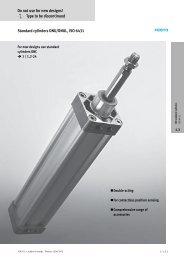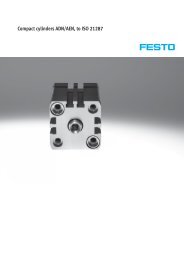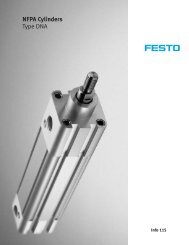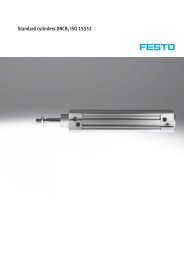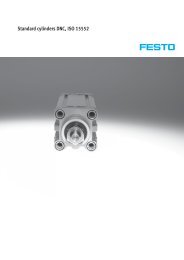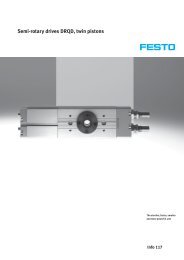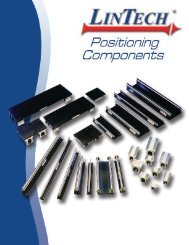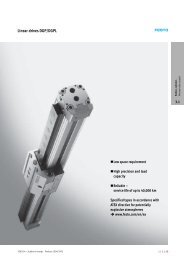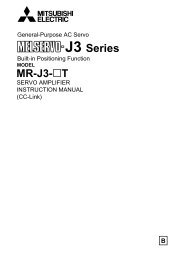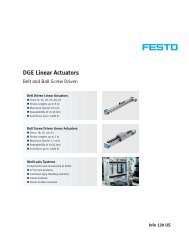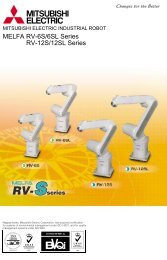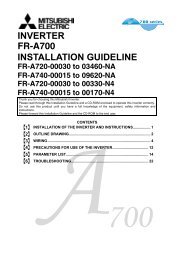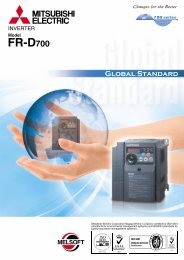RFID Systems - Allied Automation, Inc.
RFID Systems - Allied Automation, Inc.
RFID Systems - Allied Automation, Inc.
You also want an ePaper? Increase the reach of your titles
YUMPU automatically turns print PDFs into web optimized ePapers that Google loves.
<strong>RFID</strong> <strong>Systems</strong>Fundamentals of <strong>RFID</strong>What Is An <strong>RFID</strong> System?Radio Frequency Identification <strong>Systems</strong> or <strong>RFID</strong> has beenin existence in some form for over 50 years. It is simply thewireless transmission of information from a transponder (tag)to a transceiver (read head). It started as a simple binarycoded system where only a few bits of information could bestored at short read ranges and has evolved to thousands ofbytes of storage at very long distances.It is used to identify, track, sort and detect an infinite varietyof objects, including people, vehicles, garments, containers,totes and pallets. It can be used in applications such asindustrial closed loop tracking, pet/animal identification,package routing, passports, container tracking, inventorycontrol, tollbooth auto payment, logistics, and access control.Components Of AnIdentification SystemTypically, identification systems consist of a control unit, read/write heads and tags.Unique identification and customer specific information canbe saved in a targeted way on the tag. The read/write memoryareas typically range in size from 1 kbit to 256 kbits. Read/write heads can read the tag and modify the read/write portionas required by the application. This is done with a series ofcommands sent by the control unit to the read/write headsand finally, to the tag.Several read/write heads can be connected to one controlunit, which also serves as the interface to the higherlevelcontrol. Communication takes place via the currentfieldbusses such as Ethernet, PROFIBUS, DeviceNet, or viaa serial interface. Wiring between the control unit and theread/write heads is accomplished via shielded cables in orderto reduce the influence of EMC in the environment.InterfaceRead HeadTypical <strong>RFID</strong> systemFieldWhy Is It Worth Having An<strong>RFID</strong> System?<strong>RFID</strong> systems save time and money. Product tracking andidentification is possible throughout the entire assembly anddistribution cycle. It reduces the need to manually collect dataso that labor and error costs are reduced, and it makes theinformation available sooner.An <strong>RFID</strong> system enables a manufacturing facility to find out ifwork in process has been misrouted and quickly correct themistake. Data is accessible through handheld and fixed-mountTagreaders in real time, using RF signals to transfer data to andfrom tags, even in the absence of line-of-sight. The significantadvantage of all types of <strong>RFID</strong> systems is the noncontact,non-line-of-sight nature of the technology. For instance, a"good" read can occur through sunlight, wet, cold (-40 °C),frost, dirt, grease, and many corrosive chemicals.With <strong>RFID</strong> technology, companies can get real-timeinformation on inventory. Manufacturers and suppliers canrespond quickly to shifts in demand, avoid spoilage, andprevent over- and under-stocking.• Ideal for dirty, oily, wet or harsh environments• <strong>RFID</strong> is fast: tag and reader communicate in milliseconds• <strong>RFID</strong> tags and readers have no moving parts so the systemrarely needs maintenance and can operate for extendedperiods of time• No line-of-sight requirement• Long read ranges• Track tools, vehicles, and equipment in real timeIntegration Into TheNetwork Hierarchy<strong>RFID</strong> systems are integrated at the process level of sensortechnology. The control unit acts as an interface to the highercontrol system. Communication with the read/write heads andtheir parameterization takes place via this interface. All currentfieldbus interfaces and serial connections are available for the<strong>RFID</strong> control units.Commands of a PLC/PC application program are transmittedto the control unit via the fieldbus and then forwarded to theconnected read/write heads. The responses are reported tothe PLC/PC.Specifications, Standards,DirectivesMemory in the code/data carriers is electrically andmechanically robust and offers a reading reliability of nearly100% and a data retention time of more that ten years.All components are produced according to the ISO 9001International Standard and carry all the national andinternational certifications.The directive for radio and telecommunications equipment(R&TTE, 1999/5/EC) also applies to identification systems. Itdefines certain requirements that are met by complying withthe following standards: The relevant standards deal with thetopics of health (e.g., EN 50371), EMC (e.g., EN 301489), useof the radio spectrum (e.g., EN 300330/EN 300440) and theelectrical safety of equipment (e.g., EN 60950).Pepperl+Fuchs is a member of AIM (Association for AutomaticIdentification and Mobility), which promotes the applicationand standardization of identification technology. Furtherinformation is available at www.aimusa.org.Pepperl+Fuchs®<strong>Inc</strong>. • 1600 Enterprise Parkway • Twinsburg, Ohio 44087-2245 • www.am.pepperl-fuchs.comTelephone (330) 486-0001 • FAX (330) 405-4710 • E-Mail: sales@us.pepperl-fuchs.com17



